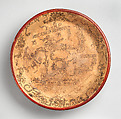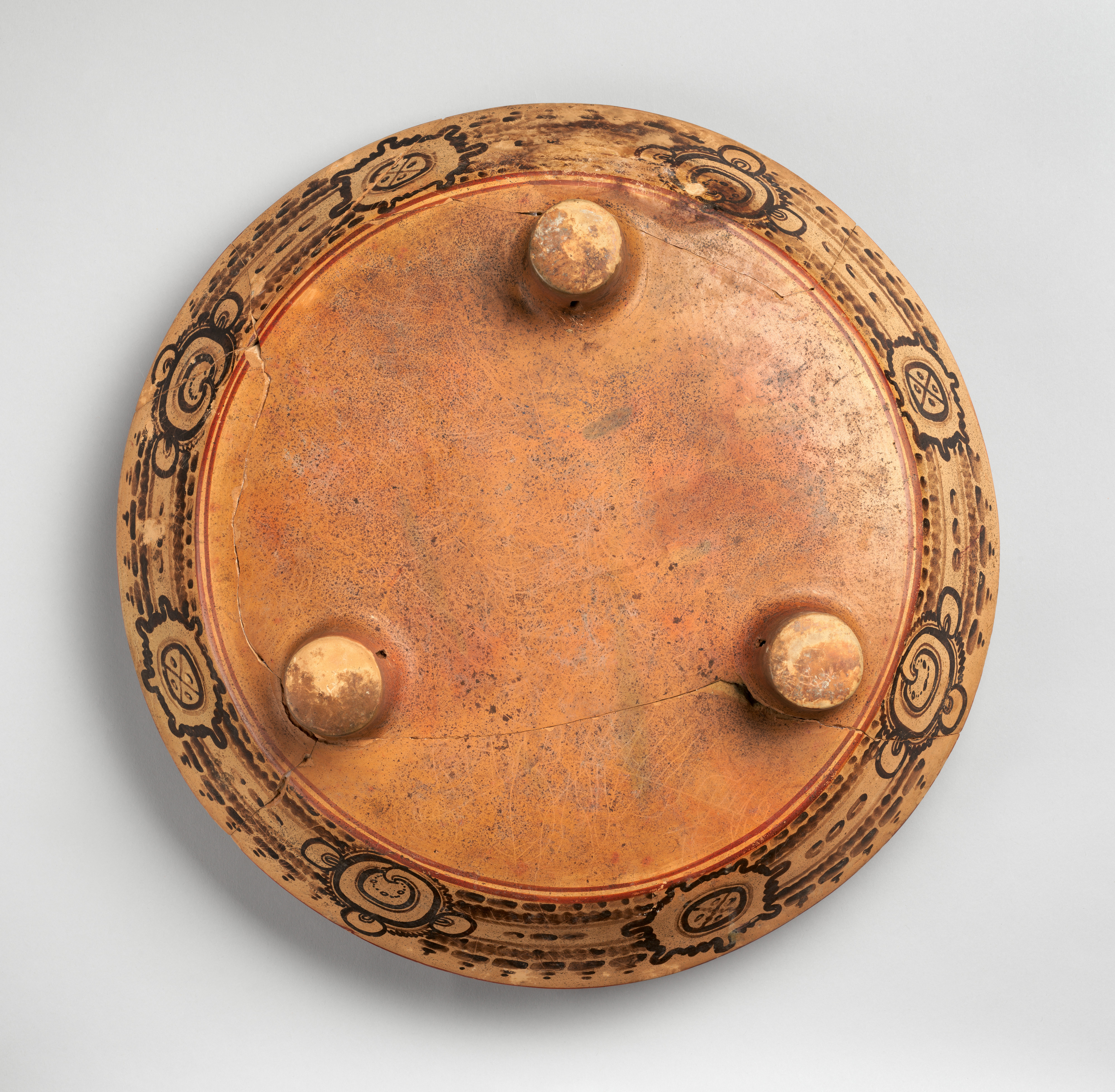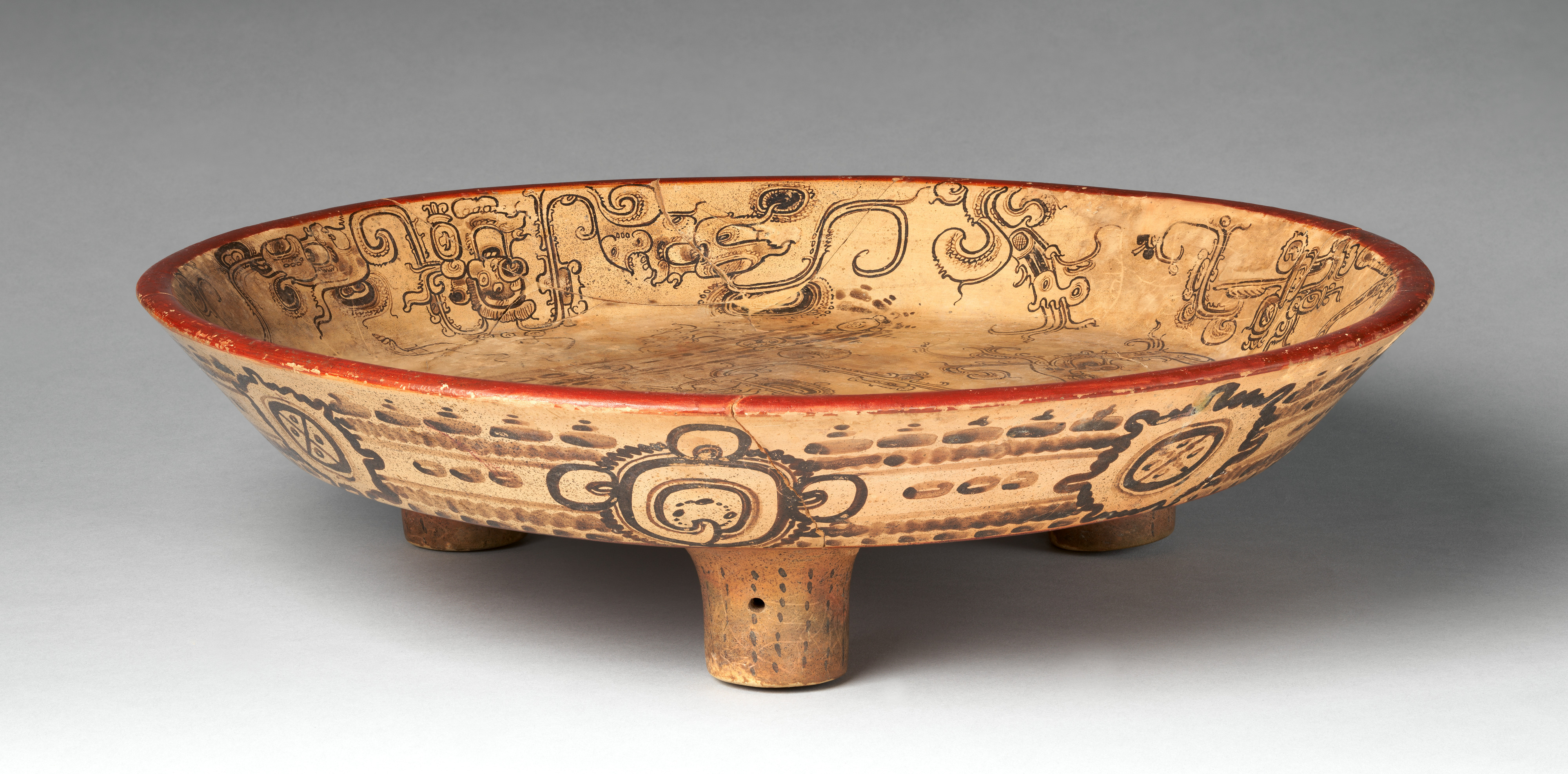Tripod plate with mythological scene
Not on view
Three hollow feet support this exceptionally large, polychrome feasting plate. The outer cream walls of its sloping rim are painted with watery motifs in black, including swirls, registers of droplets, and waterlily vegetation. The three feet of the vessel feature vertical rows of dotted lines. Each foot evokes a vertical deluge, and columns of rain appear to emerge from the plate itself and spill out of the watery milieu on its exterior.
The delicate main scene on the upper surface would only have been visible at close range by those positioned directly above the plate. It features the Maya Rain God, Chahk, waist-deep in a register of watery motifs and hieroglyphs for nahb, “sea.” From him grows three vegetal branches that morph into deities and other beings such as a roaring jaguar. Hieroglyphic texts and other motifs on the inner slope of the plate’s wide rim surround the Rain God.
This plate was painted in what is known as the codex style, a hallmark of the royal courts and loyal local palaces around the great city of Calakmul, straddling the border between southern Campeche and northern Guatemala. The unrecorded artist fused the mythic and the historical to form a microcosm on the plate’s inner surface. The mythic frame of the narrative describes the context of the sprouting rain god, named as Chahk in the text, in deep time and in a primordial place. Three Venus signs as well as the frontal and rear parts of the body of the celestial “starry Deer Crocodile” appear on either side of the upper scene, signifying the sky as the upper part of the composition. A celestial bird at the top of the scene carries what appears to be the month name, 4 Ceh, on its head as it seems to survey the scene below.
The hieroglyphic text begins with the fictive date of 13 Ok 8 Zotz. The scribe signaled the mythological time to the reader with an imaginary day-month combination. It could refer to a celestial moment from a Maya creation narrative, as the same invented date appears in the Dresden Codex in reference to the planet Venus, a point recognized by David Stuart (Miller and Schele 1986: pl. 122, pp. 310-312.). On the 13 Ok 8 Zotz date, an event “happened” (utiiy); this verb form refers to actions in deep time. The ancient subject seems to be k’uhul jinaj ? or “sacred milpa/planted-maize water,” perhaps a reference to the sprouting of maize and a phrase consistent with the overall theme of emerging vegetation on the plate.
The scribe went on to describe the mythological setting in triad: it “happened” (utiiy, this time in a more conventional, syllabic spelling) “at the black cenote, at the black water, at the five-flower house (?).” The agents at the event in deep time are probably described as the four gods of matawil (ma-ta-K’UH), which could be a reference to a watery paradise (Stuart and Stuart 2008: 211-215). The gods are named as a feline or jaguar (hi-HIX)—he appears here, roaring, head-back—and two other gods whose names are, unfortunately, partially eroded.
The rain god Chahk, named specifically as Chak-Xib-Chahk, is the undisputed protagonist of the complex scene. The prefixed name Chak, meaning “red,” may be purely coloristic or refer to a direction, East, or both, as the red sunrise. The text accords with visual clues of the three aspects of the setting. The centipede’s jaws, in a reference to the “black cenote,” frame Chahk’s watery emergence from a heavy register marked with the same hieroglyph for “black water.” There also might be a specific seasonal aspect to the scene, found in the single glyph blocks that flank the jaguar. These are variants of Wind God and sun-related glyphs, similar to the two glyphs born by characters in other monuments.
Chahk rises waist-deep from the “black water.” He takes the form of an active, dancing character, and is shown as in other depictions poised to chop with his axe (see MMA 1978.412.206; MMA 1980.213; MMA 2014.632.1). He wears his characteristic Spondylus earspools and holds the lightning axe, symbolic of the god of lightning, K’awiil. The main image of the scene is the branching head and left arm of the rain deity sprouting multiple beings (fig. 4). These include the large serpent to the left, the jaguar mentioned above, and a large “jester god” in the upper right that is recognizable by its crossed-bands motif. Some of these figures could correspond the four gods of matawil mentioned in the text, including Chahk. Moreover, that god’s left hand sprouts a personified version of obsidian in the lower right. To ancient viewers, the branching Chahk with the other gods of matawil may have been analogous to the fractal forms of eccentric flints or obsidians (see MMA 1978.412.195), as Karl Taube has suggested (personal communication, 2016).
The depiction of the watery Olympus of quadripartite gods of matawil is indeed cosmic, but with a terrestrial focus. This is especially evident when revisiting the three partially preserved figures between the “black water” band and the potential representation of the “five-flower house.” Sprouting from the lower band is the Maize God, recognizable by the characteristic elongated cranium and sporting a breath “bead.” Growing downward from the “black water” to the right of the Maize God is the torso of a figure with tobacco leaves sprouting from its head.
Presumably, maize tamales filled the plate during important meals. The plate would have contained actual maize products atop a scene in which maize growth is shown at first emergence. A plate like this could have been a grand diplomatic gesture, a gift between Maya rulers.
James Doyle, 2019
References
1981 Robicsek, Frances, and Donald Hales. The Maya Book of the Dead. Vessel 120, p. 92, 95-96. (Illustration).
1986 The Blood of Kings: Dynasty and Ritual in Maya Art. Cat. 122 (Exhibition)
1987 Stuart, David. Ten Phonetic Syllables. Research Reports on Ancient Maya Writing 14. Washington, D.C., Center for Maya Research.
1990 Schele, Linda, and David A. Freidel. A Forest of Kings: The Untold Story of the Ancient Maya. New York, William Morrow and Company, Inc. Plate 122, Fig. 2:4 (Illustration)
1992 Taube, Karl A. The Major Gods of Ancient Yucatan. Washington, Dumbarton Oaks. Fig. 4c. (Illustration)
1993 Schele, Linda, David Freidel, and Joy Parker. Maya Cosmos. New York, Harper Collins. Fig. 2:23 (Illustration)
1994 Stuart, David, and Stephen Houston. Classic Maya Place Names. Washington, Dumbarton Oaks. Fig. 92 (Illustration)
1998 Reents Budet, Dorie. Elite Maya Pottery and Artisans as Social Indicators. Archaeological Papers of the American Anthropological Association 8(1):71-89. Fig. 5.2. (Illustration)
1999 Kerr, Justin. K1609. The Maya Vase Database. http://research.mayavase.com
2001 Newsome, Elizabeth A. Trees of Paradise and Pillars of the World. Austin, University of Texas Press. Fig. 2.25 (Illustration)
2003 Looper, Matthew. Lightning Warrior: Maya art and Kingship at Quirigua. Austin, University of Texas Press. Fig. 2.25, 3.10 (Illustration)
2006 Velásquez García, Erik. The Maya Flood Myth and the Decapitation of the Cosmic Caiman. PARI Journal 7(1): 1-10. Fig. 3 (Illustration).
2010 Finamore, Daniel, and Stephen Houston (eds.). Fiery Pool: Maya and the Mythic Sea. Salem, Peabody Essex Museum. Fig. 3.10 (Illustration)
2013 Tokovinine, Alexandre. Place and Identity in Classic Maya Narratives. Washington, Dumbarton Oaks. Fig. 30a (Illustration)
2014 Kettunen, Harri and Christophe Helmke. Water in Maya Imagery and Writing. Contributions in New World Archaeology 5: 17-38. Fig. 7 (Illustration)
2015 Steinbach, Penny. Aligning the Jester God: The Implications of Horizontality and Verticality in the Iconography of a Classic Maya Emblem. In Maya Imagery, Architecture, and Activity, Maline D. Werness-Rude and Kaylee R. Spencer, eds., pp. 106-139. Fig. 2.7. (Illustration)
2016 Doyle, James A. Creation Narratives on Ancient Maya Codex-Style Ceramics in the Met’s Collections. Metropolitan Museum Journal, vol. 51, pp. 42-63. (Illustration)
2016 McDonald, J. Andrew. Deciphering the Symbols and Symbolic Meaning of the Maya World Tree. Ancient Mesoamerica 27(2): 333-359. Fig. 1 (a). (Illustration)
2017 Doyle, James, and Stephen Houston. The Universe in a Maya Plate. Maya Decipherment. 3 April 2017. https://decipherment.wordpress.com/2017/03/04/the-universe-in-a-maya-plate/
2017 Chinchilla Mazariegos, Oswaldo. Art and Myth of the Ancient Maya. New Haven, Yale University Press. Fig. 125, 126 (Illustration)
Due to rights restrictions, this image cannot be enlarged, viewed at full screen, or downloaded.
This artwork is meant to be viewed from right to left. Scroll left to view more.









